Marrying Vega and Zen: The AMD Ryzen 5 2400G Review
by Ian Cutress on February 12, 2018 9:00 AM ESTBenchmarking Performance: CPU Office Tests
The office programs we use for benchmarking aren't specific programs per-se, but industry standard tests that hold weight with professionals. The goal of these tests is to use an array of software and techniques that a typical office user might encounter, such as video conferencing, document editing, architectural modelling, and so on and so forth.
All of our benchmark results can also be found in our benchmark engine, Bench.
Chromium Compile (v56)
Our new compilation test uses Windows 10 Pro, VS Community 2015.3 with the Win10 SDK to combile a nightly build of Chromium. We've fixed the test for a build in late March 2017, and we run a fresh full compile in our test. Compilation is the typical example given of a variable threaded workload - some of the compile and linking is linear, whereas other parts are multithreaded.
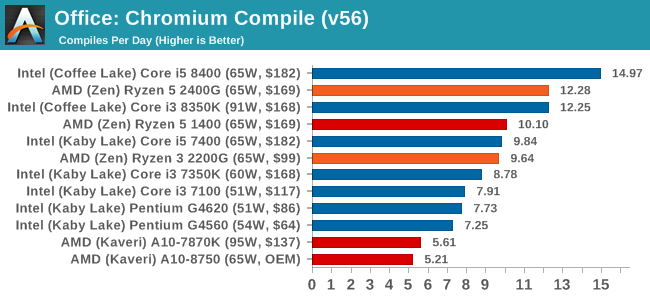
Our compile test has an eclectic mix of requirements, with different segments having different bottlenecks. The Ryzen 5 2400G matches the higher frequency of the Core i3-8350K, even though it already has a core and memory advantage. An interesting thing here is that the Ryzen 3 2200G and the Ryzen 5 1400 are almost evenly matched, even though the 1400 has double the threads. This is because of the frequency of the 2200G, and the memory speed.
PCMark 10
PCMark 10 is the latest all-in-one office-related performance tool that combines a number of tests for low-to-mid office workloads, including some gaming, but focusing on aspects like document manipulation, response, and video conferencing.

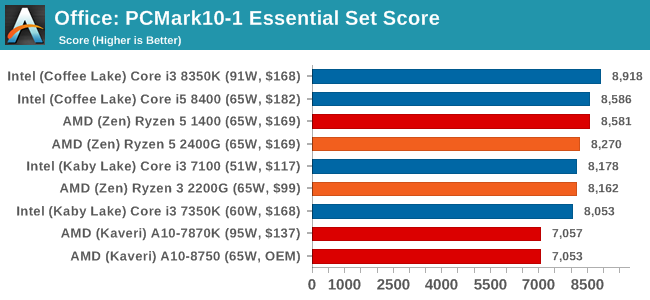
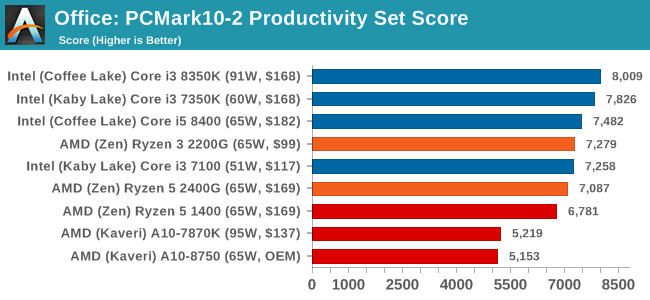
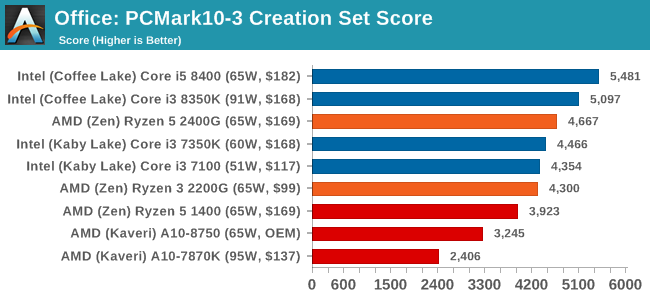
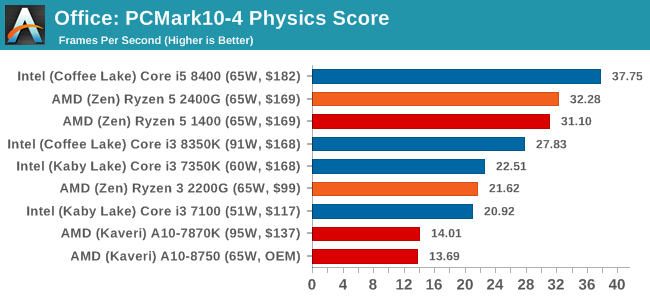
PCMark8: link
Despite originally coming out in 2008/2009, Futuremark has maintained PCMark8 to remain relevant in 2017. On the scale of complicated tasks, PCMark focuses more on the low-to-mid range of professional workloads, making it a good indicator for what people consider 'office' work. We run the benchmark from the commandline in 'conventional' mode, meaning C++ over OpenCL, to remove the graphics card from the equation and focus purely on the CPU. PCMark8 offers Home, Work and Creative workloads, with some software tests shared and others unique to each benchmark set.
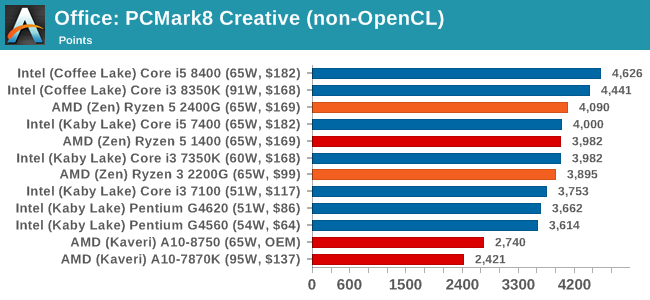
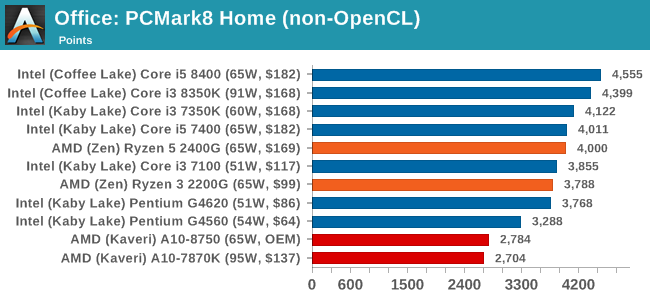
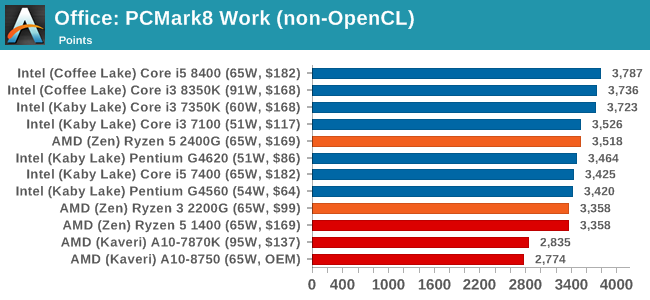










177 Comments
View All Comments
AndrewJacksonZA - Monday, February 12, 2018 - link
Hi Ian. I'm still on page one but I'm so excited! Can a 4xx Polaris card be Crossfired with this APU?prtskg - Tuesday, February 13, 2018 - link
No crossfire supported by these apus, according to AMD. You can check it out on AMD's product page.dgingeri - Monday, February 12, 2018 - link
How many PCIe lanes are available on them? I didn't see that info anywhere in the article.iter - Monday, February 12, 2018 - link
Only 8dgingeri - Monday, February 12, 2018 - link
Well, not great, but it can still run a RAID controller off the CPU lanes and a single port of 10Gbe from the chipset, or run a dual port 10Gbe from the CPU and a lower end SATA HBA from PCIex4 from the chipset with software RAID. The 2200G could make a decent storage server with a decent B350 board. I could do more with 16 lanes, but 8 is still workable. It's far cheaper than running a Ryzen 1200 with a X370 board and a graphics card with the same amount of lanes available for IO use and a faster CPU.Geranium - Monday, February 12, 2018 - link
8 PCIe Gen3 for gpu+4 Gen3 for SSD+4 Gen3 for Chipset.andrewaggb - Monday, February 12, 2018 - link
What's with the gaming benchmarks... Is there a valid reason that no games were benchmarked at playable settings? I'm going to have to go to another site to find out if these can get 60ish fps on medium or low settings.... And I thought these were being pitched at esports... so some overwatch and dota numbers might have been appropriate.AndrewJacksonZA - Monday, February 12, 2018 - link
"and can post 1920x1080 gaming results above 49 FPS in titles such as Battlefield One, Overwatch, Rocket League, and Skyrim, having 2x to 3x higher framerates than Intel’s integrated graphics. This is a claim we can confirm in this review.""These games are a cross of mix of eSports and high-end titles, and to be honest, we have pushed the quality settings up higher than most people would expect for this level of integrated graphics: most benchmarks hit around 25-30 FPS average with the best IGP solutions, down to 1/3 this with the worst solutions. The best results show that integrated graphics are certainly capable with the right settings, but also shows that there is a long way between integrated graphics and a mid-range discrete graphics option."
I would love to see which settings BF1 would have 49FPS please. Is it with everything on low, medium?
Ian Cutress - Monday, February 12, 2018 - link
I've added some sentences to the IGP page while I'm on the road. We used our 1080 high/ultra CPU Gaming suite for two reasons.Manch - Monday, February 12, 2018 - link
Which are?